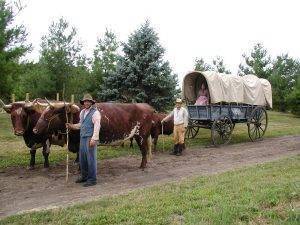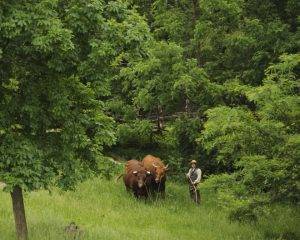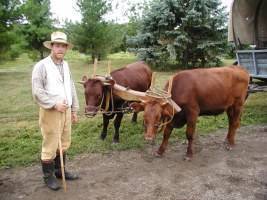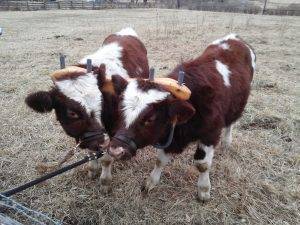CURRENT HOURS: Closed for touring until May • Open for special programs by reservation
 If you’ve visited our 1850 Farm at the museum, you’ve likely encountered our oxen – Beau and Luke. But, what is an ox? Is it a special breed or species? Nope! An ox is just a cow – one that has been trained to work as a draft animal.
If you’ve visited our 1850 Farm at the museum, you’ve likely encountered our oxen – Beau and Luke. But, what is an ox? Is it a special breed or species? Nope! An ox is just a cow – one that has been trained to work as a draft animal.
So what makes an ox an ox?
Oxen are usually male cattle. They go through extensive training starting when they are very young to teach them how to pull heavy loads and listen to their human handlers – called drovers or teamsters. They don’t actually earn the title of “ox” until they have been through four years of this training! Until then, the calves are often called “working steers”.
 Training starts when they are only a few weeks old, as they learn to be comfortable around people. The first step in an ox’s training doesn’t involve any work at all, but there is still a lot for the young calves to learn. They are taught to wear a halter and how to walk calmly on a lead rope. They learn that humans bring yummy food and soothing brushes and petting. Soon they look forward to seeing their teamsters because of the good things those people bring and do for them.
Training starts when they are only a few weeks old, as they learn to be comfortable around people. The first step in an ox’s training doesn’t involve any work at all, but there is still a lot for the young calves to learn. They are taught to wear a halter and how to walk calmly on a lead rope. They learn that humans bring yummy food and soothing brushes and petting. Soon they look forward to seeing their teamsters because of the good things those people bring and do for them. 
When they are a few months old, the calves are taught to wear their first yoke. The yoke is the piece of wood that goes across their necks and is traditionally held on with bent pieces of wood called bows. The first yoke is very small, and a team may go through a dozen or more incrementally larger yokes until they are full grown.

Besides walking alongside their teamster and wearing a yoke, the calves must learn some commands. The calves are taught words that tell them to go forward, turn left and right, stop, and back up. Here are those words, and their meanings:
 “Step Up” – go forward
“Step Up” – go forward
“Gee” – turn right
“Haw” – turn left
“Whoa” – stop
“Back” – back up
Take a look at our youngest “working steers” learning the ropes! These young steers were born at the 1850 Pioneer Farm during the summer of 2014 and are just beginning their ox training!

Read more posts on the LHF Kids Blog
Categories:
Nice steers.I raised a pair from 3 mouths to 4and a half years. They were real handy in the yoke.
When yolked together, do animals, over time, learn from one another, such as how the other walks under different conditions, bears up or pulls against different loads. Do they learn how the other navigates slopes, grades, and unevenness of terrain. Do they blend temperaments, eventually becoming more like one another? Do they begin to react to different situations in similar ways? Do they compensate for one another? I’m thinking of human identical twins I know that seem to be extensions of each other. Maybe there’s more written about this somewhere?
Curiously yours,
Thanks,
Jeff
Jeff asks some great questions that I’d love to hear answers for.
In my experience, over time if trained well the team begins to anticipate not only each other’s next move, but the commands that the teamster gives. This can be both a good and bad thing as sometimes if the team has gotten into a rhythm, any deviation will provide issues. Each of our teams does have an ox who is more willing to work, and one who is willing to let the other do the work. This is not always the case, but this is how our teams operate. When choosing a team it is important to find similar size. This way one ox is not outdoing the other. Each Ox’s personality will always be different, and they will act differently in certain situations. If the team is hand raised, it is more likely they will be more docile, more cooperative, and more likely to work as a team. Working as a team is all you can ask for. Lastly, if separated, it is easy to tell if the animals are closely bonded, as there will be some separation anxiety. Hope this helps. The best resource I have found on Oxen is; Oxen: A Teamster’s Guide to Raising, Training, Driving & Showing by Drew Conroy. – Tynan Shadle, 1850 Farm Manager
Great Information. Thank you!
Thanks for sharing such useful information
I have one oxen in the yoke with another oxen who goes down to get out of work. How can I get him not to do this without cruelty and loosing trust. He gets stubborn
I was looking to find out what a Devon Red Ox looked like. I read it in a book and was curious. As I was looking I came across this picture and article; it is very fascinat-ing. I would love to be able to have a pair, but we live in Oregon on a plot of land that is only 50 ft. x 300 ft. What state are you in?
Living History Farms is located in Urbandale, IA.